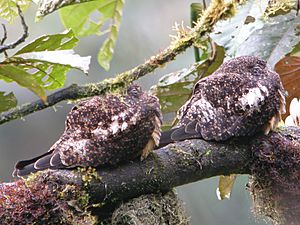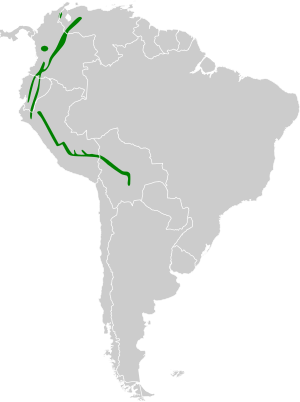Rufous-bellied nighthawk facts for kids
Quick facts for kids Rufous-bellied nighthawk |
|
|---|---|
 |
|
| Conservation status | |
| Scientific classification | |
| Genus: |
Lurocalis
|
| Species: |
rufiventris
|
 |
|
The rufous-bellied nighthawk (Lurocalis rufiventris) is a cool bird that belongs to the nightjar family. Sometimes, people also call it Taczanowski's nighthawk. You can find this bird in several South American countries, including Bolivia, Colombia, Ecuador, Peru, and Venezuela.
Contents
About the Rufous-bellied Nighthawk
The rufous-bellied nighthawk is a special bird. For a while, scientists thought it was just a type of short-tailed nighthawk. But now, they agree it's its own unique species! This bird is also monotypic, which means it's the only species in its group.
What Does the Rufous-bellied Nighthawk Look Like?
This nighthawk is about 23 to 25 centimeters (9 to 10 inches) long. Its back and wings are dark brown. They have cool rufous (reddish-brown) and buff (pale yellowish-brown) spots and speckles.
Its tail is brown with light brown or grayish-brown stripes. The tip of its tail is usually pale. The bird's chin is dark brown, and its throat is white. Its chest is dark brown, and its belly and sides are a tawny buff color.
Where the Rufous-bellied Nighthawk Lives
The rufous-bellied nighthawk lives in the Andes mountains. You can find it in western Venezuela and parts of Colombia, Ecuador, Peru, and Bolivia.
It likes to live in humid mountain cloudforests. These are forests that are often covered in clouds or mist. In Ecuador and Peru, these birds live at high elevations. They are found between 1,500 and 3,450 meters (about 4,900 to 11,300 feet) above sea level.
How the Rufous-bellied Nighthawk Behaves
You will usually see rufous-bellied nighthawks alone or in pairs. They are most active when the sun is setting, during dusk. During the day, they like to rest lengthwise on tree branches. This helps them blend in with the tree bark!
What the Rufous-bellied Nighthawk Eats
This nighthawk catches its food while flying. Scientists believe it eats insects, but they haven't studied its diet in detail yet.
Reproduction and Life Cycle
Scientists don't know much about how the rufous-bellied nighthawk reproduces. They think it might be similar to its close relative, the short-tailed nighthawk. The short-tailed nighthawk lays just one egg directly on a horizontal tree branch.
What Sounds Does It Make?
The rufous-bellied nighthawk has a special song. It's a fast series of notes that get lower in pitch. It sounds like "kwa-kwa-kwa-kwa-ko." The bird sings this song both while flying and when it's sitting on a branch. It also makes other sounds, like a soft "pow," a series of soft coos that rise in pitch, and a low growl.
Is the Rufous-bellied Nighthawk Safe?
The IUCN (International Union for Conservation of Nature) says the rufous-bellied nighthawk is a species of "Least Concern." This means it's not in immediate danger of disappearing.
Even though its population might be getting a little smaller, it's not declining fast enough to be a big worry right now. The bird lives in a large area. The main threat it faces is the destruction of its forest home.
See also
 In Spanish: Añapero ventrirrufo para niños
In Spanish: Añapero ventrirrufo para niños


